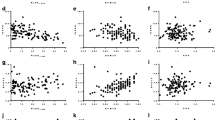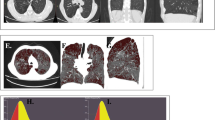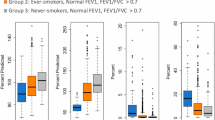Abstract
Purpose
Severity of chronic obstructive pulmonary disease (COPD) can be graded using the classification released in the Global Initiative for Chronic Obstructive Lung Disease (GOLD) report. Such classification is essentially based on spirometry and does not recognise the role of other measures. The aim of this study was to assess whether the GOLD stages correlate with the extent of pulmonary emphysema and other ancillary computed tomography CT features in a population of smokers with stable COPD.
Materials and methods
Based on clinical assessment and lung-function testing, patients were classified according to the GOLD criteria. CT scans were visually evaluated for extent of emphysema and airway abnormalities.
Results
A total of 43 patients were enrolled. The amount of emphysema was described as minimal in six patients with stage 0, and as moderate in seven patients with stage 0. In stages I and II, the extent of emphysema ranged from minimal to severe, whereas we observed the presence of severe emphysema in most patients in stages III and IV. According to the regression model, only CT emphysema extent independently predicted the GOLD stage (r 2=0.58; p<0.001). The cutoff value of emphysema extent of 31.5% allowed us to distinguish patients with a GOLD stage ≥III.
Conclusions
Although we found a significant correlation between CT emphysema extent and GOLD stages, different percentage of emphysema extent can be observed among each GOLD stage. The upper limit of 31.5% of emphysema extent may indicate a boundary for a clinically worsening status.
Riassunto
Obiettivo
La gravità della broncopneumopatia cronica ostruttiva (BPCO) può essere classificata impiegando una stadiazione stilata dal Progetto Mondiale per la Diagnosi, il Trattamento e la Prevenzione della Broncopneumopatia Cronica Ostruttiva (Global Iniziative for the diagnosis, Management and Prevention of Chronic Obstructive Lung Disease — GOLD). Tale classificazione è basata essenzialmente sulla spirometria e non riconosce il ruolo di altri parametri. Lo scopo del nostro studio è valutare se le classi GOLD correlano con l’estensione dell’enfisema polmonare ed altre caratteristiche rilevabili alla TC in una popolazione di fumatori con BPCO in fase stabilizzata.
Materiali e metodi
Sulla base dei test di funzionalità polmonare e sulla valutazione clinica, i pazienti sono stati classificati secondo i criteri GOLD. Le scansioni TC sono state studiate visivamente per valutare l’estensione dell’enfisema e le anomalie delle vie aeree.
Risultati
Sono stati esaminati 43 pazienti. La quantità di enfisema era minima in 6 pazienti in stadio 0, mentre in 7 pazienti nella stessa classe era moderata. Nelle classi I ed II, l’estensione dell’enfisema variava da minima a severa, mentre nella maggior parte dei pazienti in stadio III e IV abbiamo osservato enfisema di grado severo. Secondo il modello di regressione, soltanto il valore di estensione dell’ enfisema, valutato alla TC, ha predetto in modo indipendente la classe GOLD (r 2=0,58; p<0,001). Il valore cut-off di estensione dell’enfisema pari a 31,5% ci ha permesso di distinguere i pazienti appartenenti ad uno stadio GOLD superiore a III.
Conclusioni
Anche se abbiamo trovato una correlazione significativa fra l’estensione dell’ enfisema alla TC e le classi GOLD, una percentuale differente di enfisema può essere osservata in ciascuna di esse. Il cut-off di 31,5% nell’estensione dell’enfisema può indicare un valore limite per una condizione di peggioramento clinico del paziente.
Similar content being viewed by others
References/Bibliografia
Pauwels RA, Buist AS, Calverley PM et al; GOLD Scientific Committee (2001) Global strategy for the diagnosis, management, and prevention of chronic obstructive pulmonary disease. NHLBI/WHO Global Initiative for Chronic Obstructive Lung Disease (GOLD) Workshop summary. Am J Respir Crit Care Med 163:1256–1276
Global Initiative For Chronic Obstructive Lung Disease™. GOLD workshop report update 2004. http://www.goldcopd.com
O’Donnell RA, Peebles C, Ward JA et al (2004) Relationship between peripheral airway dysfunction, airway obstruction, and neutrophilic inflammation in COPD. Thorax 59:837–842
Omori H, Nakashima R, Otsuka N et al (2006) Emphysema detected by lung cancer screening with low-dose spiral CT: prevalence, and correlation with smoking habits and pulmonary function in Japanese male subjects. Respirology 11:205–210
Antonelli-Incalzi R, Imperiale C, Bellia V et al; SaRA Investigators (2003) Do GOLD stages of COPD severity really correspond to differences in health status? Eur Respir J 22:444–449
de Marco R, Accordini S, Cerveri I et al; European Community Respiratory Health Survey Study Group (2004) An international survey of chronic obstructive pulmonary disease in young adults according to GOLD stages. Thorax 59:120–125
Pinto-Plata VM, Cote C, Cabral H et al (2004) The 6-min walk distance: change over time and value as a predictor of survival in severe COPD. Eur Respir J 23:28–33
Celli BR, Cote CG, Marin JM et al (2004) The body-mass index, airflow obstruction, dyspnea, and exercise capacity index in chronic obstructive pulmonary disease. N Engl J Med 350:1005–1012
Bergin C, Muller N, Nichols DM et al (1986) The diagnosis of emphysema. A computed tomographic-pathologic correlation. Am Rev Respir Dis 133:541–546
Gevenois PA, de Maertelaer V, De Vuyst P et al (1995) Comparison of computed density and macroscopic morphometry in pulmonary emphysema. Am J Respir Crit Care Med 152:653–657
Dirksen A, Friis M, Olesen KP et al (1997) Progress of emphysema in severe alpha 1-antitrypsin deficiency as assessed by annual CT. Acta Radiol 38:826–832
Gierada DS, Slone RM, Bae KT et al (1997) Pulmonary emphysema: comparison of preoperative quantitative CT and physiologic index values with clinical outcome after lung-volume reduction surgery. Radiology 205:235–242
Kazerooni EA, Whyte RI, Flint A, Martinez FJ (1997) Imaging of emphysema and lung volume reduction surgery. Radiographics 17:1023–1036
Sverzellati N, Chetta A, Calabro E et al (2005) Reliability of quantitative computed tomography to predict postoperative lung function in patients with chronic obstructive pulmonary disease having a lobectomy. J Comput Assist Tomogr 29:819–824
Ueda K, Kaneda Y, Sudoh M et al (2005) Role of quantitative CT in predicting hypoxemia and complications after lung lobectomy for cancer, with special reference to area of emphysema. Chest 128:3500–3506
Casanova C, Cote C, de Torres JP et al (2005) Inspiratory-to-total lung capacity ratio predicts mortality in patients with chronic obstructive pulmonary disease. Am J Respir Crit Care Med 171:591–597
Grenier P, Cordeau MP, Beigelman C (1993) High-resolution computed tomography of the airways. J Thorac Imaging 8:213–229
Zweig MH, Campell G (1993) Receiver-operating characteristic (ROC) plots. A fundamental evaluation tool in clinical evaluation. Clin Chem 39:561–577
Aziz ZA, Wells AU, Desai SR et al (2005) Functional impairment in emphysema: contribution of airway abnormalities and distribution of parenchymal disease. AJR Am J Roentgenol 185:1509–1515
Gurney JW, Jones KK, Robbins RA et al (1992) Regional distribution of emphysema: correlation of high-resolution CT with pulmonary function tests in unselected smokers. Radiology 183:457–463
Cosio MG, Snider GL (2001) Chest computed tomography: is it ready for major studies of chronic obstructive pulmonary disease? Eur Respir J 17:1062–1064
Hogg JC, Chu F, Utokaparch S et al (2004) The nature of small-airway obstruction in chronic obstructive pulmonary disease. N Engl J Med 350:2645–2653
Silvers GW, Maisel JC, Petty TL et al (1974) Flow limitation during forced expiration in excised human lungs. J Appl Physiol 36:737–744
Wright JL, Lawson LM, Pare PD et al (1984) The detection of small airways disease. Am Rev Respir Dis 129:989–994
Reid J, Cockcroft D (2002) Severe centrilobular emphysema in a patient without airflow obstruction. Chest 121:307–308
Clark KD, Wardrobe-Wong N, Elliott JJ et al (2001) Patterns of lung disease in a “normal” smoking population: are emphysema and airflow obstruction found together? Chest 120:743–747
Tsushima K, Sone S, Yoshikawa S et al (2006) Clinical differences in the Global Initiative for Chronic Obstructive Lung Disease Stage 0. Respir Med 100:1360–1367
Vestbo J, Lange P (2002) Can GOLD Stage 0 provide information of prognostic value in chronic obstructive pulmonary disease? Am J Respir Crit Care Med 166:329–332
Kohler D, Fischer J, Raschke F, Schonhofer B (2003) Usefulness of GOLD classification of COPD severity. Thorax 58:825
Hogg JC, Wright JL, Wiggs BR et al (1994) Lung structure and function in cigarette smokers. Thorax 49:473–478
Gelb AF, Hogg JC, Muller NL et al (1996) Contribution of emphysema and small airways in COPD. Chest 109:353–359
Jones PW, Willits LR, Burge PS, Calverley PM; Inhaled Steroids in Obstructive Lung Disease in Europe study investigators (2003) Disease severity and the effect of fluticasone propionate on chronic obstructive pulmonary disease exacerbations. Eur Respir J 21:68–73
Loubeyre P, Paret M, Revel D et al (1996) Thin-section CT detection of emphysema associated with bronchiectasis and correlation with pulmonary function tests. Chest 109:360–365
Mishima M, Itoh H, Sakai H et al (1999) Optimized scanning conditions of high resolution CT in the follow-up of pulmonary emphysema. J Comput Assist Tomogr 23:380–384
Madani A, Keyzer C, Gevenois PA (2001) Quantitative computed tomography assessment of lung structure and function in pulmonary emphysema. Eur Respir J 18:720–730
Hruban RH, Meziane MA, Zerhouni EA et al (1987) High resolution computed tomography of inflationfixed lungs. Pathologic-radiologic correlation of centrilobular emphysema. Am Rev Respir Dis 136:935–940
Muller NL, Staples CA, Miller RR, Abboud RT (1988) “Density mask”. An objective method to quantitate emphysema using computed tomography. Chest 94:782–787
Nakano Y, Sakai H, Muro S et al (1999) Comparison of low attenuation areas on computed tomographic scans between inner and outer segments of the lung in patients with chronic obstructive pulmonary disease: incidence and contribution to lung function. Thorax 54:384–389
Author information
Authors and Affiliations
Corresponding author
Rights and permissions
About this article
Cite this article
Pescarolo, M., Sverzellati, N., Verduri, A. et al. How much do GOLD stages reflect CT abnormalities in COPD patients?. Radiol med 113, 817–829 (2008). https://doi.org/10.1007/s11547-008-0284-3
Received:
Accepted:
Published:
Issue Date:
DOI: https://doi.org/10.1007/s11547-008-0284-3
Keywords
- Chronic obstructive pulmonary disease
- Global Initiative for Chronic Obstructive Lung Disease guidelines
- High-resolution CT




